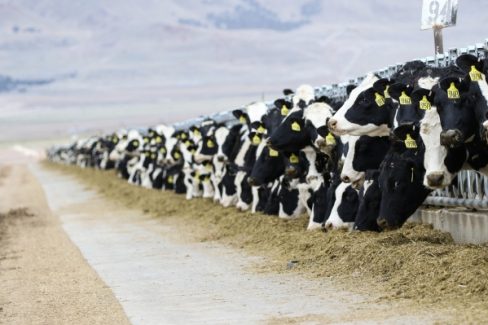Good domestic demand for cheese here at home along with strong exports of other dairy products abroad are helping to keep milk prices at record levels so far this year. Dr. Bob Cropp, professor emeritus with the University of Wisconsin Cooperative Extension, said in his monthly Dairy Situation and Outlook report that milk production is also a key factor leading to the higher prices. He says total milk output was flat during the final months of 2013 and stayed relatively weak, especially in Wisconsin, during the first part of the new year.
“January’s milk production for the U.S. was up just 1.0-percent and February’s production was up 1.1-percent,” Cropp points out. “Milk cow numbers, which had small increases last December and January, did not increase in February resulting in cow numbers slightly lower than a year ago.”
He says the cheese markets on the Chicago Mercantile Exchange have been showing both barrels and blocks in record territory during certain times in February and March. That resulted in the February Class III price elevating up to a record $23.35, with March looking just as promising, he said.
“The February average U.S. All Milk Price was a record $24.70 and will average near $25 for March. Compared to March a year ago the Class III price will be about $6.40 higher, the Class IV price $5.85 higher and the average U.S. All Milk Price $5.90 higher.”
The report went on to say that exports of dairy products set a record last year totaling 15.5-percent of U.S. milk production on a total solids basis. That trend continued into January, with exports of nonfat dry milk/skim milk powder up 22-percent; and total cheese shipments 46-percent higher.
Meanwhile, as the prices for milk goes up, farmers are enjoying a period of time where their outputs are going down. Corn prices were around $4.50 per bushel compared to near $7 a year ago, and alfalfa hay is averaging lower for most parts of the country.
“The severe drought is not impacting milk production at this time,” Cropp feels. “With much stronger milk prices and feed cost lower than a year ago except for alfalfa hay California dairy farmers are producing all the milk they can to pay down accumulated debt incurred from the crash in milk prices back in 2009 and high feed prices the fall and winter of 2012-13 from the drought of 2012.”
He says that since many producers are still recovering from the depressed milk prices in 2009 followed by the widespread drought over the past two years, many are paying off accumulated debt rather than expanding their operations–which means production won’t be exceeding demand anytime soon.
Cropp concludes by saying we can expect milk prices to average lower for the second half of the year, but no sharp decline in milk prices is anticipated. The Class III price will likely in the $20 to $19 range by early summer and end the year near $18.




